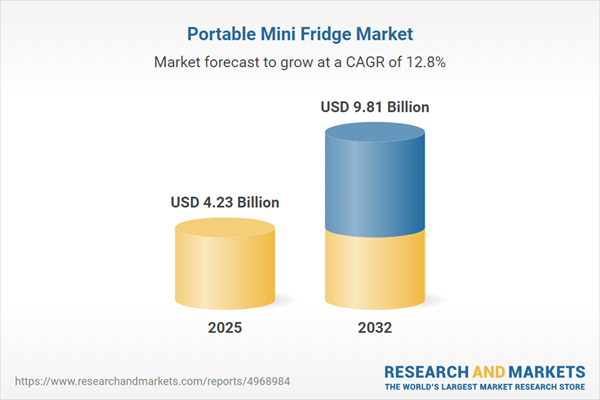Speak directly to the analyst to clarify any post sales queries you may have.
The portable mini fridge market is undergoing significant evolution, shaped by dynamic shifts in consumer expectations, advances in refrigeration technology, and changes in trade policy. Senior executives and decision-makers require actionable insights to navigate these complex forces and capitalize on arising growth opportunities.
Market Snapshot: Sizing the Portable Mini Fridge Opportunity
The portable mini fridge market grew from USD 3.75 billion in 2024 to USD 4.23 billion in 2025. It is forecast to expand steadily at a CAGR of 12.76%, anticipating a market value of USD 9.81 billion by 2032. Technology-driven innovation, evolving consumer lifestyles, and a heightened awareness of health and wellness are driving robust market activity across multiple industry verticals. Regulatory scrutiny, supply chain adaptation strategies, and the emergence of new business models are establishing new competitive benchmarks.
Scope & Segmentation of the Portable Mini Fridge Market
This research delivers a comprehensive evaluation across product, application, and geographical segments, illuminating how market nuances can shape strategic planning and resource allocation.
- Cooling Mechanism Types: Absorption, Compressor, Thermoelectric
- End Use Categories: Commercial, Residential
- Application Areas: Cosmetics & Personal Care, Food & Beverage, Medical & Pharmaceuticals
- Capacity Ranges: Up To 20 L, 21 To 40 L, Above 40 L
- Distribution Channels: Offline (Convenience Stores, Hypermarkets & Supermarkets, Specialty Stores), Online (Direct-To-Consumer, E-Commerce)
- Regional Coverage: Americas (United States, Canada, Mexico, Brazil, Argentina, Chile, Colombia, Peru), EMEA (United Kingdom, Germany, France, Russia, Italy, Spain, Netherlands, Sweden, Poland, Switzerland, United Arab Emirates, Saudi Arabia, Qatar, Turkey, Israel, South Africa, Nigeria, Egypt, Kenya), Asia-Pacific (China, India, Japan, Australia, South Korea, Indonesia, Thailand, Malaysia, Singapore, Taiwan)
- Leading Companies Analyzed: Haier Smart Home Co., Ltd., Midea Group Co., Ltd., LG Electronics Inc., Samsung Electronics Co., Ltd., Whirlpool Corporation, Hisense Electric Co., Ltd., Electrolux AB, Panasonic Holdings Corporation, Dometic Group AB, ARB Corporation Limited
Key Takeaways for Decision-Makers
- Heightened demand for portable mini fridges is originating from diverse sectors beyond residential, including healthcare, beauty, and professional environments.
- Integration of energy-efficient compressor systems and connectivity enhancements, such as smart sensors, is increasing end-user value and competitive differentiation.
- Sustainability expectations are influencing supplier investment in eco-friendly refrigerants and recyclable materials, aligning with new environmental mandates and customer requirements.
- Direct-to-consumer strategies and tailored service offerings, including subscriptions and extended warranties, are supporting long-term brand loyalty.
- Space-saving designs are critical for urban markets, while off-grid and healthcare applications are expanding the relevance of absorption technology and traceability features.
Tariff Impact: Implications of 2025 U.S. Adjustments
The 2025 introduction of new U.S. tariffs on key refrigeration components and finished goods has triggered re-evaluation of supplier networks and manufacturing footprints. Companies are actively exploring nearshore assembly, optimizing regional trade agreements, and simplifying component design to manage escalating input costs and ensure continuity of supply. These initiatives, paired with increased collaboration across public and private sectors, reflect a drive toward greater resilience and fiscal sustainability in response to shifting policy landscapes.
Methodology & Data Sources
This report applies rigorous secondary research paired with qualitative and quantitative primary interactions. Data has been collected from industry publications, regulatory documents, and validated through stakeholder interviews along the value chain—including manufacturers, buyers, and end users—supplemented with structured surveys and expert consultations to ensure actionable, reliable analysis.
Why This Report Matters for Senior Executives
- Enables data-driven decisions by detailing segment-specific growth drivers, competitive profiles, and regional adoption pathways in the portable mini fridge market.
- Highlights critical risks and opportunities arising from technology integration, evolving supply chain models, and changing regulatory environments.
- Offers practical recommendations to optimize product portfolios, enhance supply resilience, and strengthen market positioning amid ongoing transformation.
Conclusion
The portable mini fridge market is poised for continued transformation as innovation, sustainability, and shifting consumer use cases converge. Executives who align strategies with these evolving dynamics are most likely to realize sustained growth and competitive differentiation in this sector.
Additional Product Information:
- Purchase of this report includes 1 year online access with quarterly updates.
- This report can be updated on request. Please contact our Customer Experience team using the Ask a Question widget on our website.
Table of Contents
3. Executive Summary
4. Market Overview
7. Cumulative Impact of Artificial Intelligence 2025
Companies Mentioned
The companies profiled in this Portable Mini Fridge market report include:- Haier Smart Home Co., Ltd.
- Midea Group Co., Ltd.
- LG Electronics Inc.
- Samsung Electronics Co., Ltd.
- Whirlpool Corporation
- Hisense Electric Co., Ltd.
- Electrolux AB
- Panasonic Holdings Corporation
- Dometic Group AB
- ARB Corporation Limited
Table Information
| Report Attribute | Details |
|---|---|
| No. of Pages | 185 |
| Published | October 2025 |
| Forecast Period | 2025 - 2032 |
| Estimated Market Value ( USD | $ 4.23 Billion |
| Forecasted Market Value ( USD | $ 9.81 Billion |
| Compound Annual Growth Rate | 12.7% |
| Regions Covered | Global |
| No. of Companies Mentioned | 11 |









